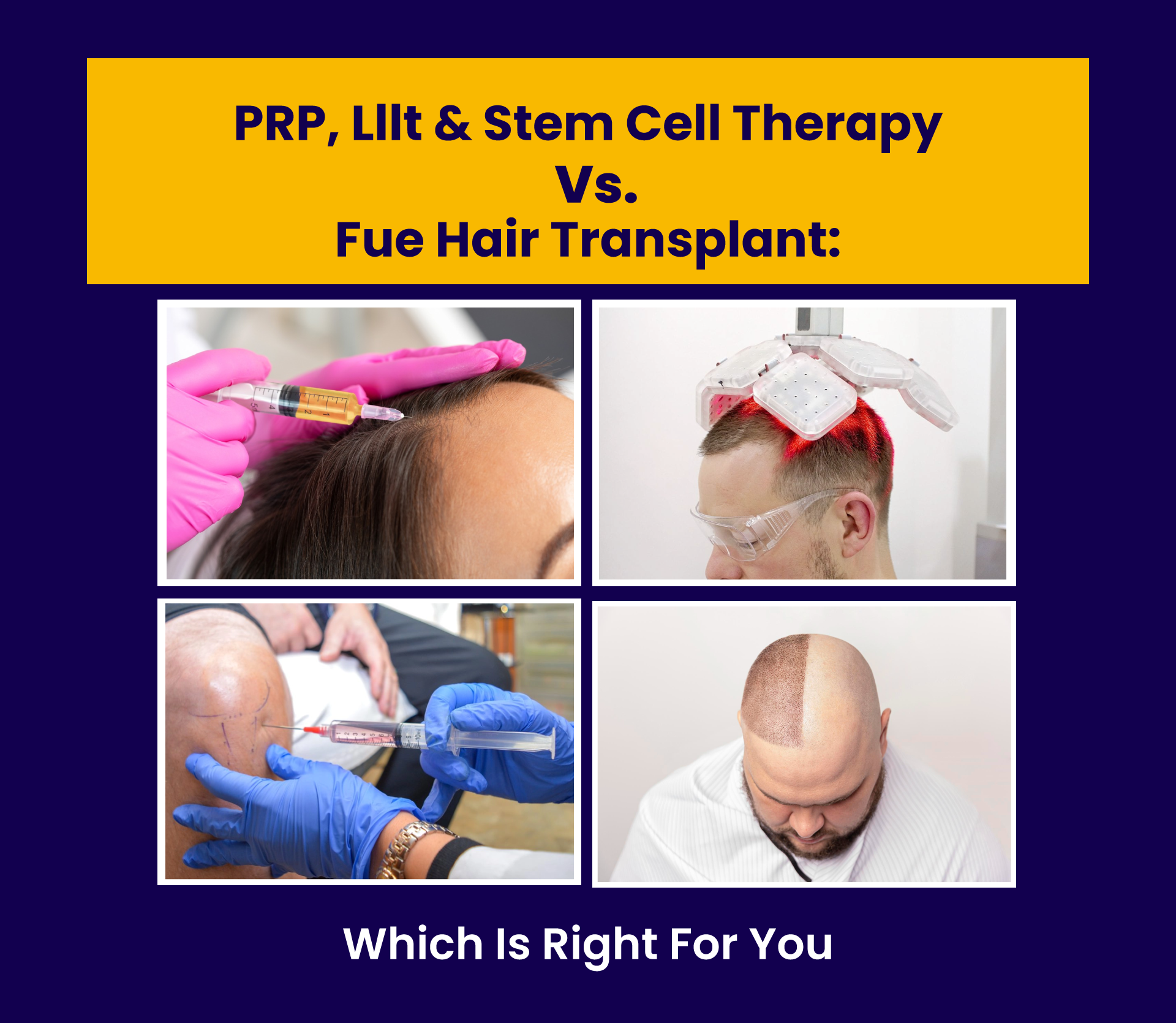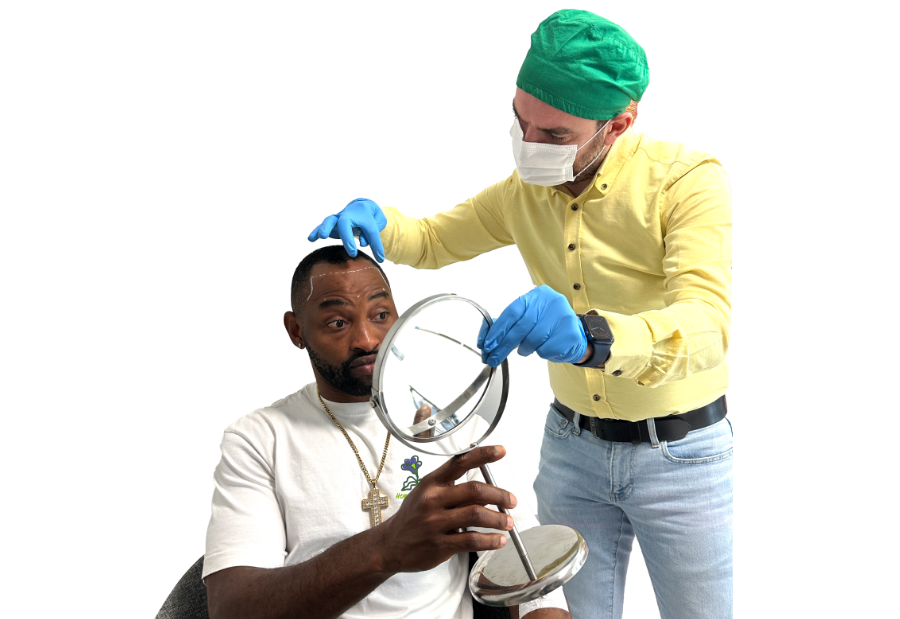Get 25% OFF Hair Transplant Packages This New Year — Book Today!
PRP, LLLT & Stem Cell Therapy vs. FUE Hair Transplant: Which Is Right for You?

The treatment options for hair loss have been advancing quickly in the last ten years. More individuals are utilizing options such as PRP, LLLT, and stem cells, which are less invasive, rather than having hair transplant surgery right away. That said, FUE Hair Transplant in Turkey are still the worldwide leader in patients seeking long-lasting hair growth. So what is the best option and for whom?
Let us go over the options to help you choose.
Understanding the Basics of Hair Restoration Treatments
What is PRP (Platelet-Rich Plasma) Therapy?
PRP stands for platelet-rich plasma. In this treatment, your blood is drawn, processed to isolate plasma rich in growth factors, and then injected into the scalp. This nourishes hair follicles and improves circulation in the area, which encourages regrowth.
Who’s it good for? If your hair is thinning or you’re just starting to see some recession, PRP might be ideal. It doesn’t work overnight, but with 3 to 4 sessions spaced weeks apart, many people see visible thickening over 3 to 6 months. Just search for PRP for hair loss before and after and you’ll see what we mean.
The best part? There’s barely any downtime. But you do need to stay consistent.
If you are curious about PRP hair treatment cost, you can check the detailed breakdown.
How Low-Level Laser Therapy (LLLT) Stimulates Hair Growth
Laser therapy isn’t science fiction anymore. LLLT uses red light wavelengths to boost cell metabolism and promote healthier hair growth. It’s delivered through devices like helmets, caps, and combs.
Helmet-style units are hands-free and convenient. Combs offer more control but can feel time-consuming. Light caps are somewhere in between.
While it’s painless and generally safe, patience is key. You’ll likely wear the device several times a week for 10 to 20 minutes, with noticeable improvement only after a few months. Some report irritation or scalp dryness, but most find it manageable.
Stem Cell Hair Regeneration Explained
Now here’s where things get futuristic. Stem cell hair treatment involves taking a small tissue sample, usually from your scalp or fat layer, then extracting regenerative cells. These are injected back into the scalp to wake up dormant follicles.
It’s not a quick fix. This treatment is still under study and not yet FDA-approved, but some clinics in Europe and Asia offer it under clinical protocols.
In places like Turkey, hair stem cell transplantation is getting attention for its potential, especially when used with FUE hair transplant in Turkey. Results can take several months, and costs are steep due to the complexity. But for those who don’t qualify for a transplant or want to delay surgery, this may be a fascinating option.
FUE (Follicular Unit Extraction) Hair Transplant: A Quick Overview
What Happens in an FUE Procedure?
FUE hair transplant in Turkey is a form of surgical hair restoration that extracts individual follicular units, one by one, from the donor area (usually the back of the scalp) and implants them into bald spots.
The procedure is done under local anesthesia. There’s no major scarring, just tiny dot marks that fade over time. Recovery usually takes 7 to 10 days, with full results appearing in 6 to 12 months. People looking for visual proof often turn to FUE hair transplant in Turkey with before-and-after images, which are pretty convincing.
Cost of FUE vs Non-Invasive Options
Here’s where your budget gets a vote.
- PRP costs moderate amounts per session, with packages often available for long-term treatment.
- LLLT is a one-time investment in a device, making it affordable over time.
- Stem cell therapy sits on the high end, given its experimental nature.
- FUE hair transplant in Turkey clinics offer more competitive pricing compared to the US or UK, making it a global hotspot for medical tourism.
Just keep in mind: cheap isn’t always better. Look for the best place to get a hair transplant, not just the cheapest.
Non-Invasive Hair Treatments vs FUE: Side-by-Side Comparison
| Treatment | Invasiveness | Results Timeline | Cost | Risk |
| PRP | Non-Invasive | 3–6 Months | Moderate | Low |
| LLLT | Non-Invasive | 4–12 Weeks | Low to Moderate | Minimal |
| Stem Cell Therapy | Minimally Invasive | Experimental | High | Medium |
| FUE Transplant | Invasive | 6–12 Months | High | Moderate |
Who Should Choose Non-Invasive Options?
If your hair loss is in early stages, your scalp still has active follicles, and you’re nervous about surgery, non-invasive treatments are worth trying first. Many people in their 20s and 30s respond well to PRP and LLLT, especially when started early.
Non-invasive options are also good for people who can’t afford downtime or want to avoid scars. Just know they take more patience and regular follow-ups.
When FUE Might Be the Better Choice
There’s a point where serums and light therapy just don’t cut it. If you’ve got advanced baldness or patterned hair loss with shiny patches of scalp, FUE hair transplant in Turkey is likely your best bet.
It’s not magic, but it’s the closest thing we have to long-term hair restoration with real volume. Results may take time, but they tend to last. Plus, a good transplant can restore not just your hairline but your confidence too.
If you are confused about which method is right for you, this detailed comparison of DHI vs FUE hair transplant will help you understand the differences clearly.
Can You Combine PRP, LLLT, or Stem Cells with FUE?
Absolutely. Many clinics now offer hybrid therapies. PRP is often used after an FUE procedure to speed up healing and encourage stronger graft survival. LLLT can support recovery and help maintain existing hair.
Hair stem cell transplantation Turkey clinics are also exploring combo packages that include both stem cell injections and transplants to improve density.
This layered approach can give you the best of both worlds: faster results and better long-term maintenance.
If you are looking for natural and permanent results, the best FUE hair transplant option is explained in detail here to help you make an informed decision.
Patient Experiences: What Real People Say
- “PRP helped thicken my crown within 4 months.”
- “Laser cap was easy and worked slowly but surely.”
- “Stem cells gave me hope; I just wish it was cheaper.”
- “FUE was painful, but I got my hairline back!”
Everyone’s story is different, but one common theme stands out: the earlier you take action, the better your chances.
Final Verdict: PRP, LLLT, Stem Cells or FUE?
There’s no universal winner here. Each method has its place. If your hair loss is new and mild, PRP or LLLT could give you a solid boost. If you want something more permanent and you’re dealing with visible bald spots, FUE hair transplant in Turkey might be your path forward.
For those open to cutting-edge science, stem cell hair treatment offers exciting potential, but it’s not for the faint of budget.
A smart approach? Talk to a specialist who can look at your hair loss pattern, medical history, and goals. The best place for a hair transplant will never pressure you into one method. They’ll guide you toward what’s right for you.
FAQs
Is PRP better than FUE?
They work differently. PRP supports thinning hair and delays progression, while FUE replaces lost follicles. Choose based on your condition.
Can LLLT regrow hair permanently?
It helps maintain and strengthen existing hair. It’s not a miracle cure, but it can be a great support tool when used consistently.
Is stem cell therapy for hair FDA-approved?
No, it is still under clinical study in most regions and hasn’t received broad regulatory approval yet.

